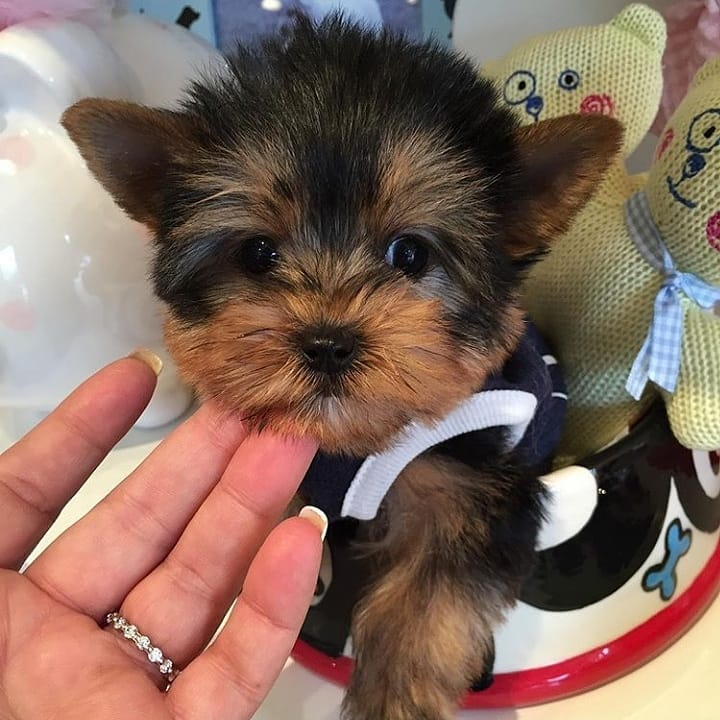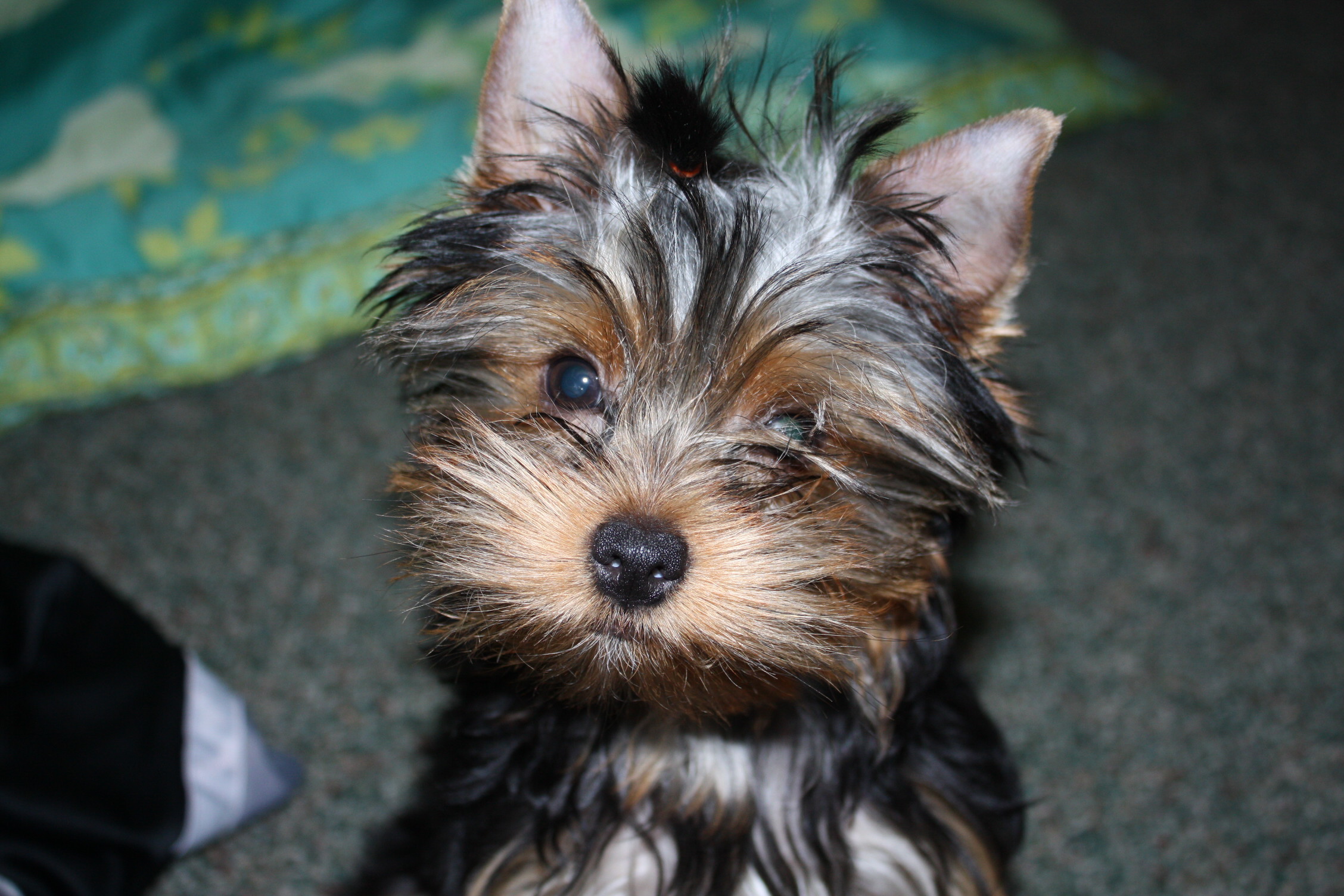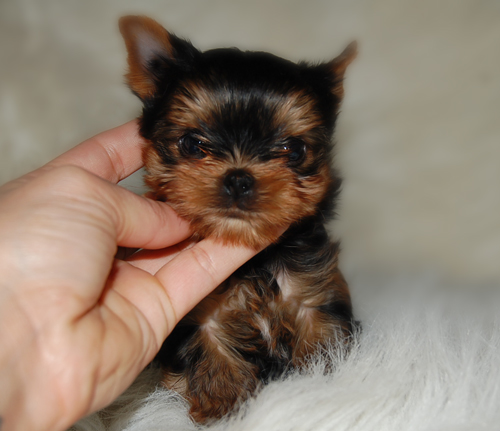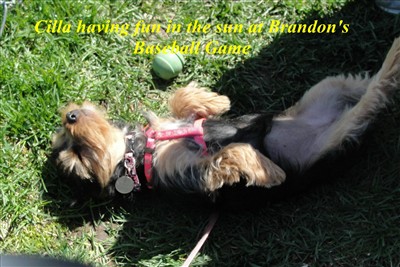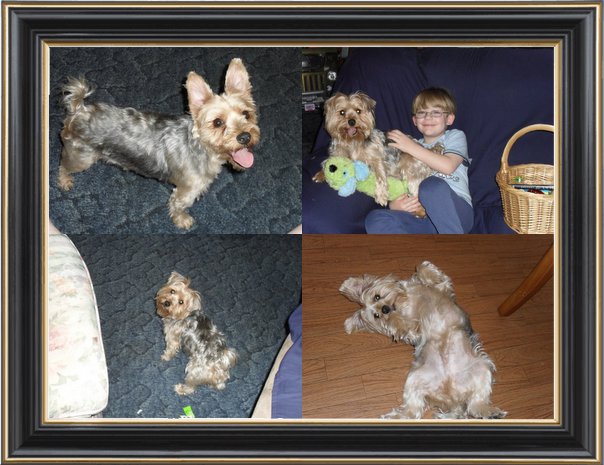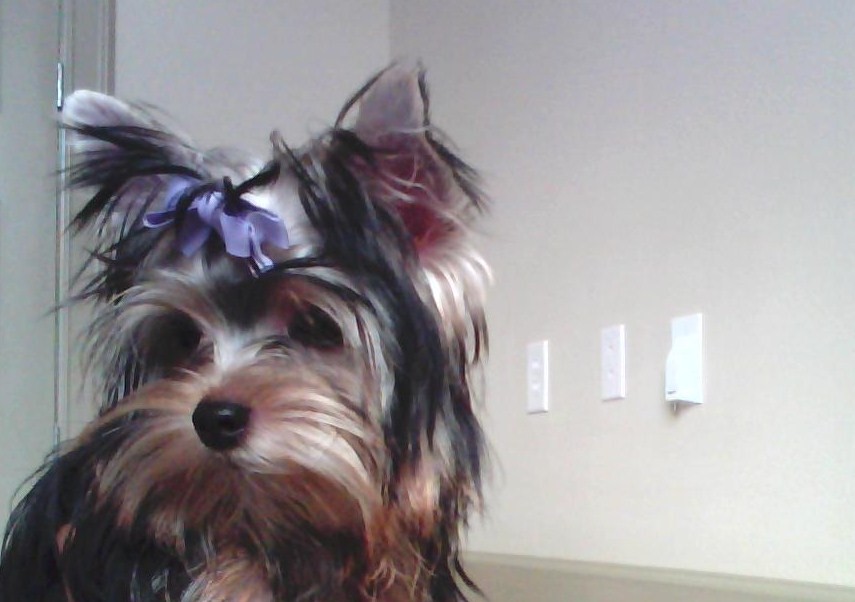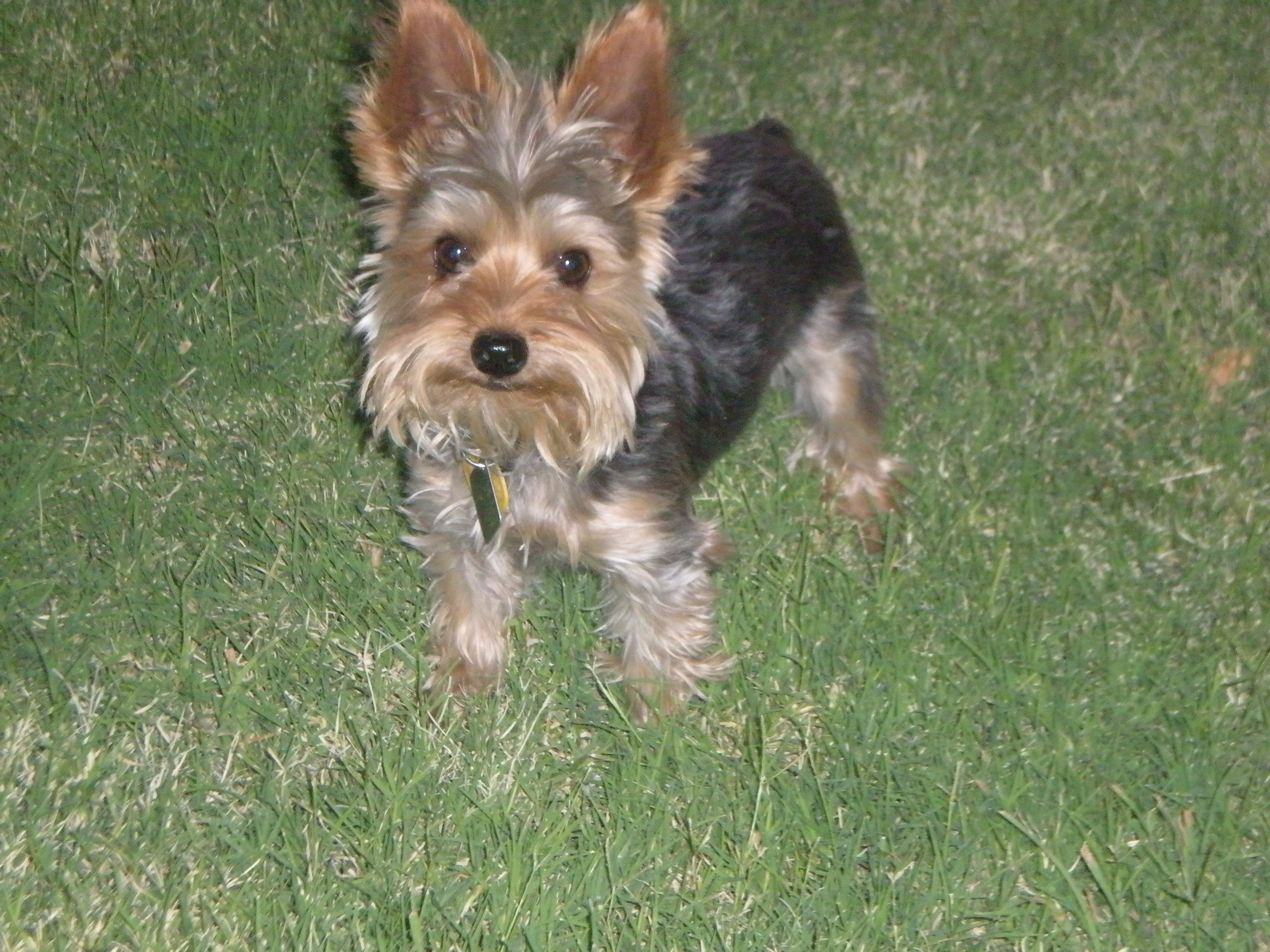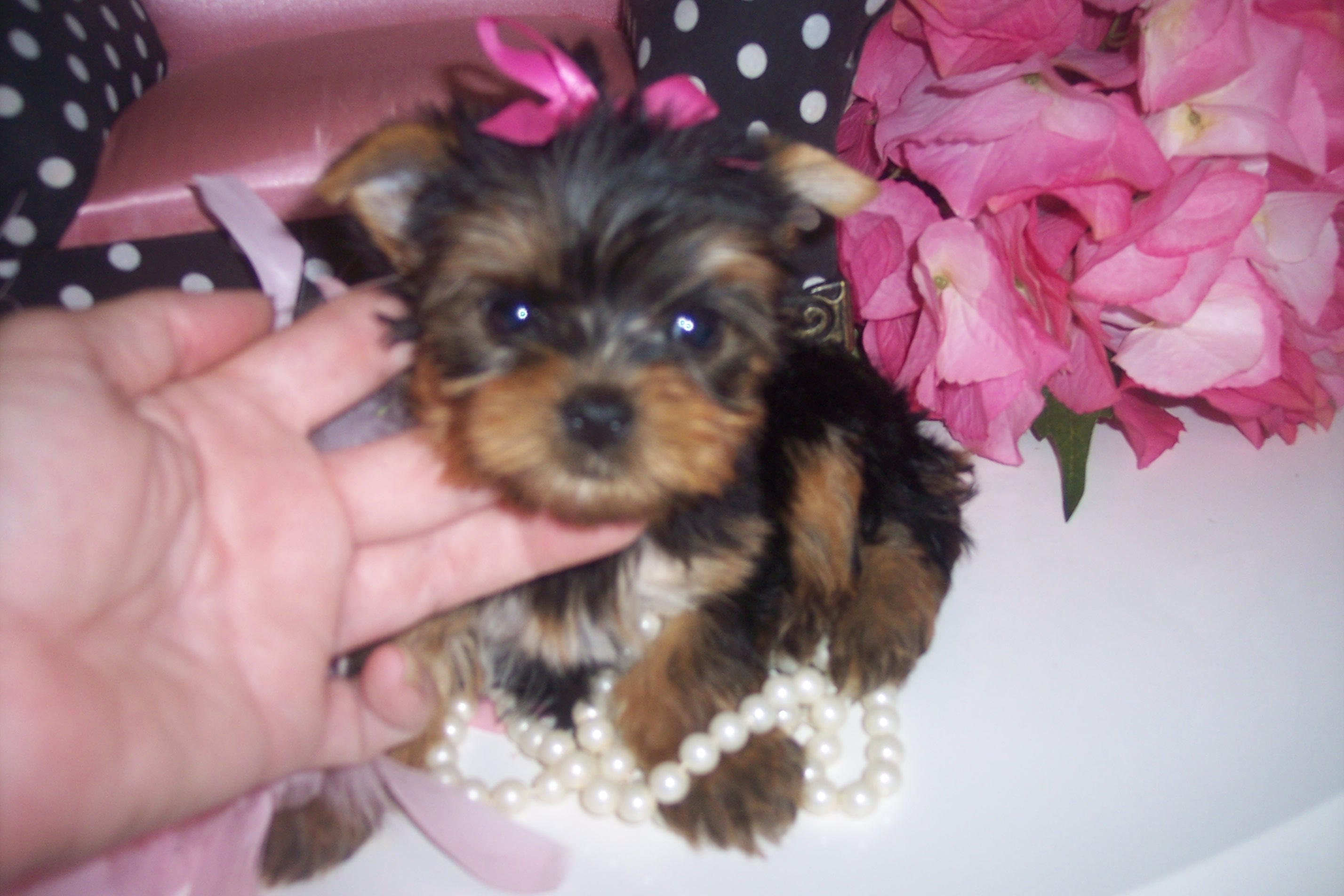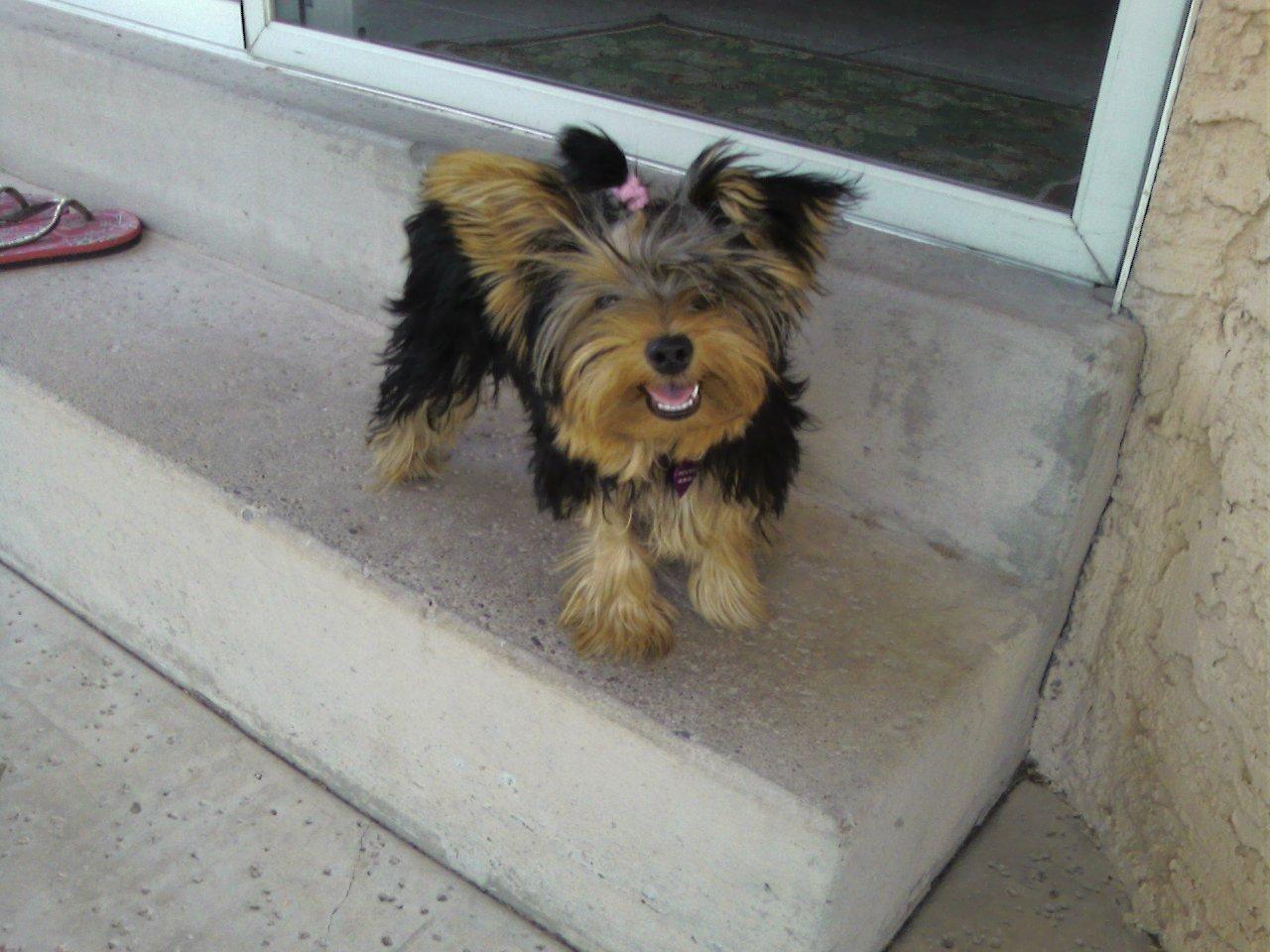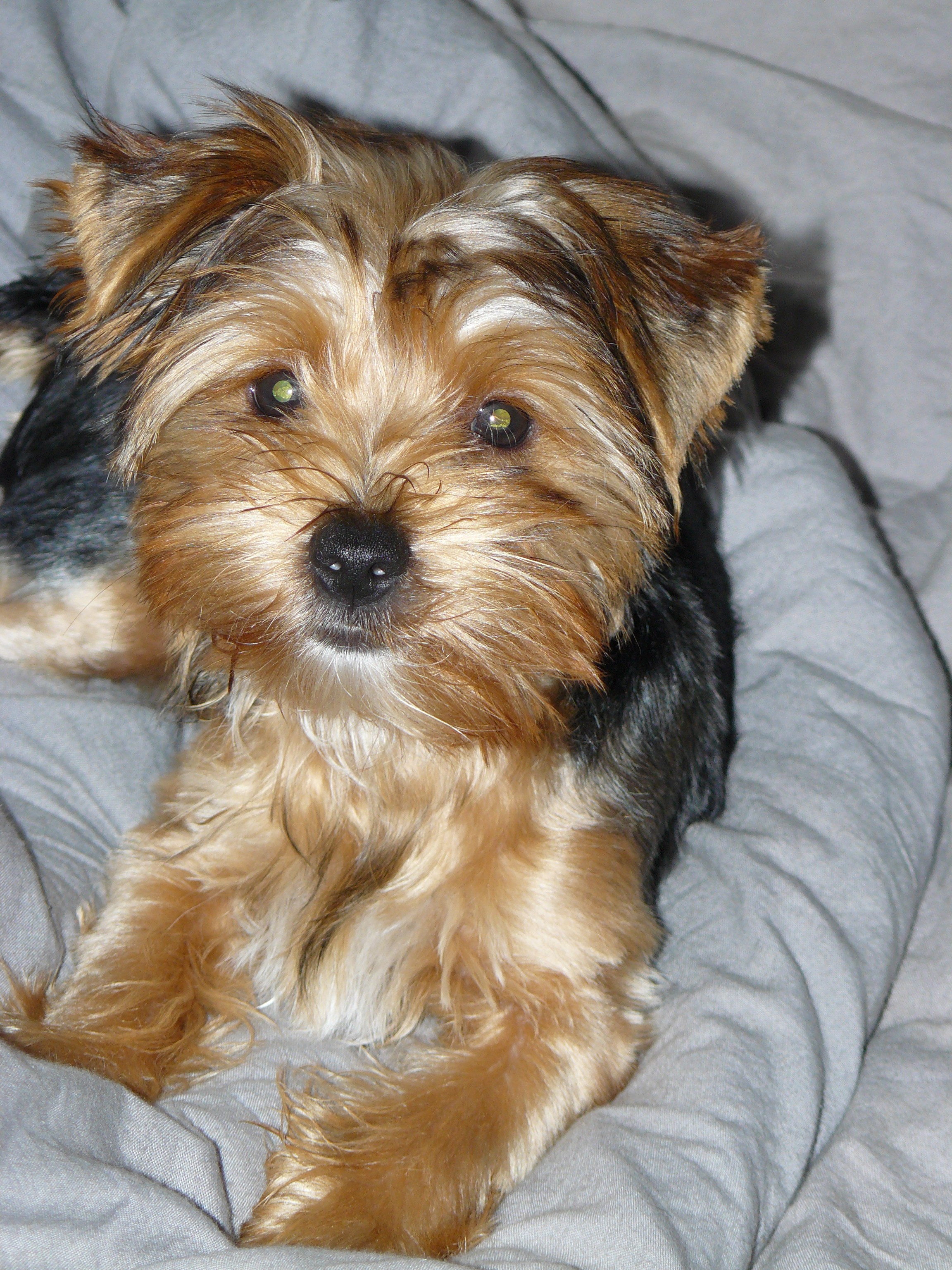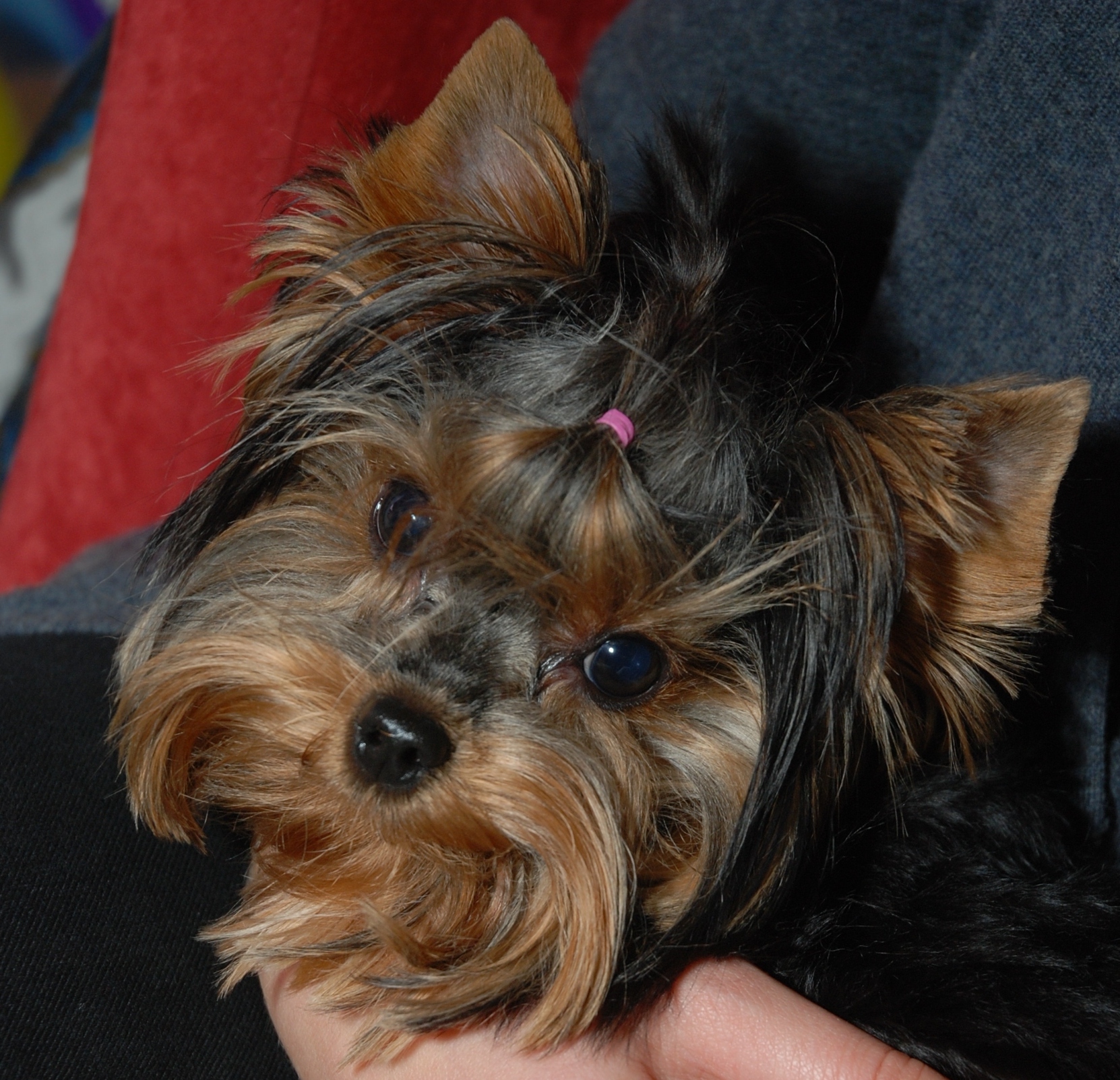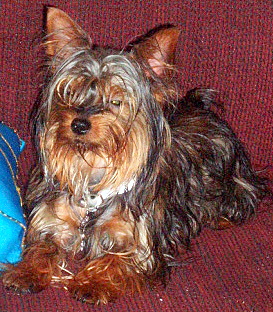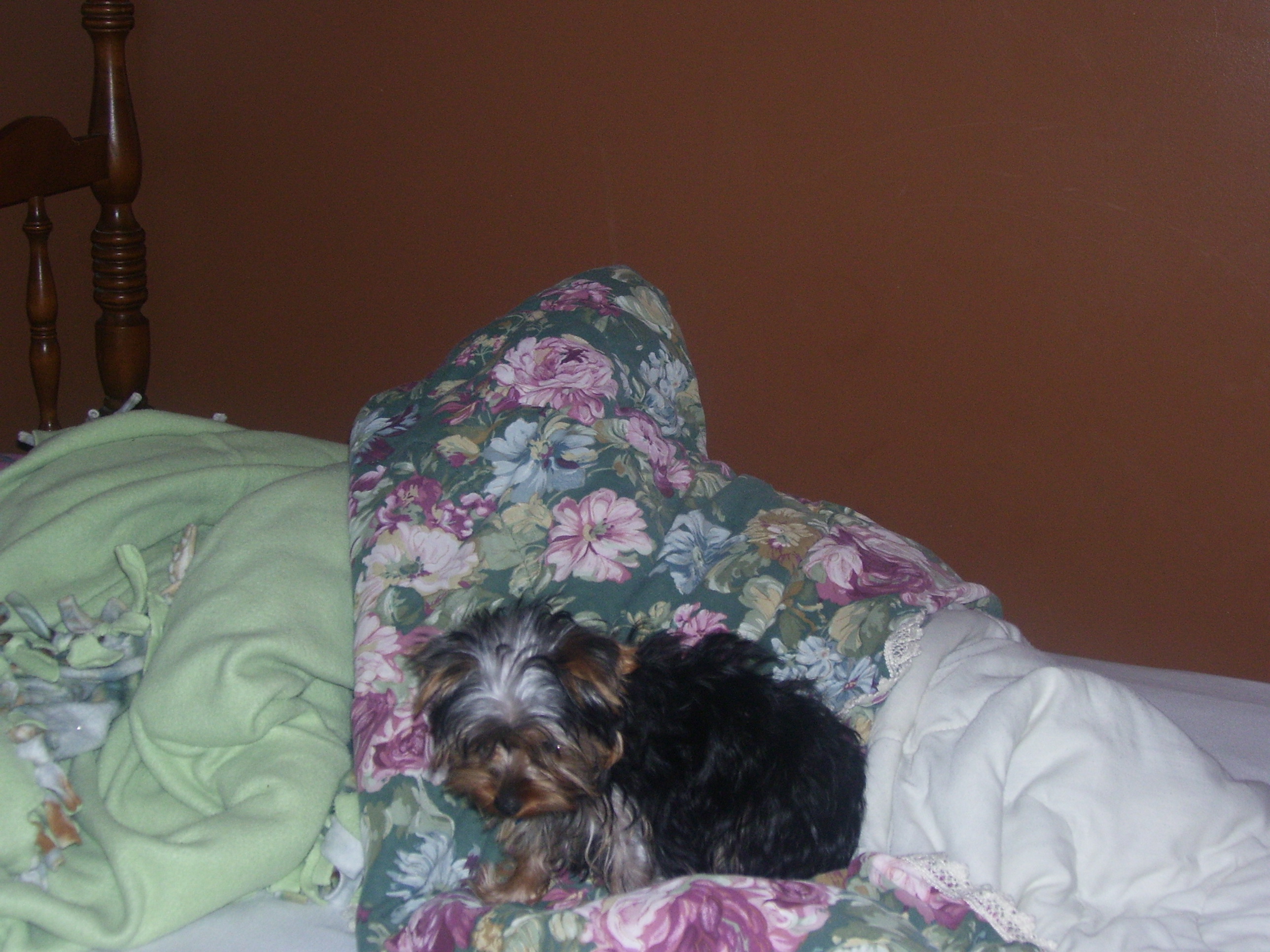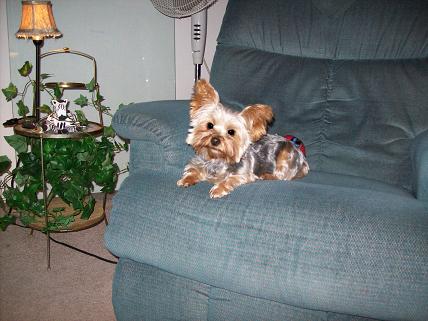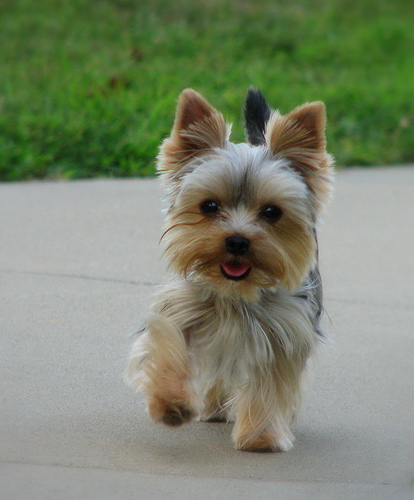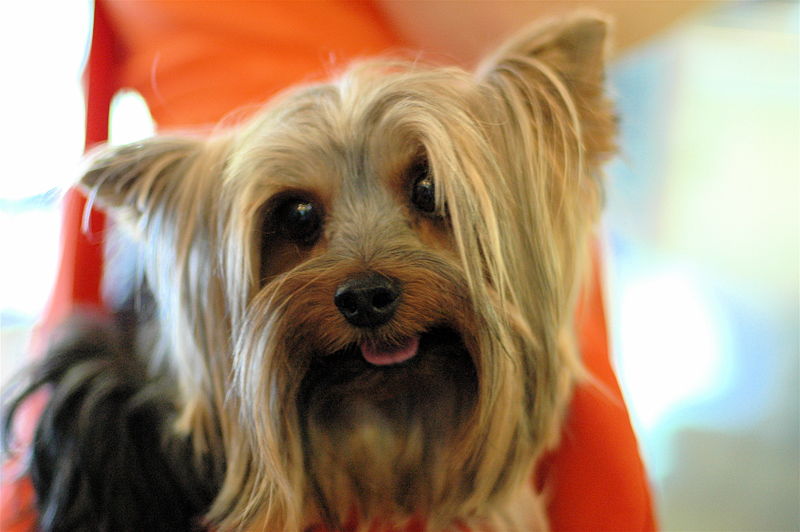
(Yorkie) The Yorkshire Terrier is a long-haired toy terrier with a well-proportioned body and a clean, compact appearance. They carry themselves proudly and exude an aura of self-confidence and vigor. They have a comparatively short back and a level back line. The height at the dog’s rump is approximately the same as the height at the dog’s shoulders. The breed’s hind legs are straight when viewed from behind, but their stifles are noticeably bent when viewed from the profile angle. Their forelegs are straight, and their elbows stick neither in nor out. Feet of this breed are round and feature a set of black toenails. The Yorkshire Terrier has a small head with a top that is nearly flat. Their skull is slightly rounded, not too prominent, and features a well-proportioned muzzle. Their sound teeth close in a scissors or level bite and their nose is black in color. They have dark, sparkling eyes and a pair of small, V-shaped ears that are carried erect. The coat of the Yorkshire Terrier is glossy, silky, and fine in texture. The hair across the dog’s body is comparatively long and absolutely straight. The hair is parted on the dog’s face from the base of the dog’s skull to the end of the tail. Hair should hang down evenly on both sides of the dog’s body. The hair on the muzzle is very long. The coat color for this breed is steel blue across the dog’s body and tail and tan everywhere else. Puppies are usually born black and tan. Tails of this breed are customarily docked to half of their original length.
User added infoCoat color on the head should be a clear gold, to match breed standards. Some Yorkies hair tends to gray as they age. Some will turn completely gray over time.
add infoThe Yorkshire Terrier has a big personality, despite its small size. They are mischievous, spunky, and they seek out opportunities for adventure. They are full of energy and courage, and they are very loyal, clever, and determined. While they are sometimes leery of strangers, they are very affectionate with members of their own family. They do not like to be teased or pestered, and they generally get along best with older, more considerate children. They can get snappish if they are frightened or surprised. Like many other terrier breeds, the Yorkshire Terrier can be aggressive towards strange dogs and small animals. While this breed can sometimes be a bit stubborn, they are generally responsive to commands and easy to train. They like to bark, but they can easily be taught not to do so.
The Yorkshire Terrier is very friendly with children, likes to be taken on walks and likes to play games with owner. They are very intelligent and do well with all types of training. The Yorkshire Terrier is also very good in training.
add infoSome lines of Yorkshire Terriers are prone to bronchitis and early tooth decay. They are sometimes unable to tolerate anesthetic treatment, and occasionally, their digestive systems are very delicate. As a result of herniated disks and other types of spine problems, the Yorkshire Terrier is at a mild risk for paralysis in the hindquarters. Falls can cause their delicate bones to fracture. Female Yorkshire Terriers often have problems delivering. The tiny “teacup” variety of Yorkshire Terrier frequently suffers from serious behavioral and health problems. Yorkshire Terriers should not be given exotic treats, and they should be fed dried food to help keep their teeth strong and clean. Regular teeth cleaning should also be given to these dogs by a veterinarian. This breed typically lives for 12 to 15 years.
add infoThe Yorkshire Terrier is a breed that is approximately 100 years old. Its specific origins are unknown. This is likely due to the fact that the breed was produced by a group of English working men who refrained from giving away the secret to their breeding success. These working men of north England created the Yorkshire Terrier to hunt rats in mine shafts and dig into badger and fox burrows. It’s also probable that Scotsmen seeking work in the mills of Yorkshire brought various types of terriers with them. Such terriers included the Skye Terrier and the Clydesdale Terrier (now extinct). These breeds were crossed with several local breeds like the long-haired Leeds Terrier. Many believe the Maltese, the Black and Tan Manchester, and the Dandie Dinmont Terrier may have also contributed to the breed’s development. The original Yorkshire Terrier was much bigger than the version we see today. Selective breeding has produced a Yorkshire Terrier that is much smaller in size. The first specimen that exhibited the characteristics demanded by its contemporary standard was shown in 1870.
add infoThe long-haired, silky coat of the Yorkshire Terrier needs regular grooming. Clipped coats should be brushed and combed on an almost daily basis. This breed’s teeth should be cleaned frequently. The Yorkshire Terrier is a minimal shedder.
add infoThe Yorkshire Terrier is well-suited to life in a small household or apartment. They are a very active breed indoors, and they do not require a yard. This breed will benefit from regular physical activity and exercise, and they enjoy having the opportunity to run around and play. This breed is sensitive to harsh weather conditions and prefers a warmer climate.
They need an occasionally walks. They are good in apartment living. Even though they look like they can handle all types of weather they prefer a warm climate. Although small in size, they tolerate cold weather conditions well. If they are kept in long coat, hot climates are less well tolerated.
add info| Puppies For Sale | Find a Breeder | Rescue a Dog |
|---|---|---|
| Be the First to take out an Ad! |

Berlin, DE
Die Hobbyzucht im „Butzemannhaus“ ist geprägt von Liebe und Respekt gegenüber den Tieren. Ich sehe meine Tiere nicht... |
Be the First to take out an Ad! |
 |
What is the life cycle of a Yorkshire Terrior? I'm not sure what your asking but they typically live for 12-15 years. Although, I've heard of them making it to 17 years. They have plenty of engergy but start to slow down a little bit around 8 years. During the later years the dog will probably like to lounge around. |
 |
Hi i`m thinking maybe the female will follow the trained male yorkie and when he goes you let the female go woth him this way it will teach her to go to the toilet outside, i have rescued a yorkshire pup that was strayed at christmas and i have a border collie and she is doing what he does they are so funny together daisy mae is my 6th yorkshire terrier |
 |
What do you do when their hair[or coat] makes you allergic? Their coat is supposed to be silk and not fur so it's kind of like human hair. So you shouldn't be allergic to this breed. |
 |
How many times a day should they be feed? for a 2 month old to a 5 month old yorkie pup 4 small meals a day isfine try giving them 1 meal a day from 1year and up |
 |
I think maybe they're getting used to sleeping. Small dogs like this are active and can't stay put. Maybe to train them, try exhausting them before bed time. This should get the tired out and make them fall asleep faster. Give them a treat or toy when ever they are quiet. Hopefully it works! |
 |
Well, maybe half true. Usually this is common in most small dogs. First of all, they don't have a large blatter to hold all that fluid. But if your up to it, take them out every few hours. This should help. Blessings with the house trainging:) |
 |
Clear the anal glands which can get gummed up. |
 |
You probably could...just dont put them together like the first day or two just in case they dont get along,let them sniff each other under supervision.. when you think they're ready you can let them "meet" lol again under supervision. |
 |
The Yorkshire terrier is not any "barkier" then any other breed. They will alert to a strange sudden sound or if a stranger arrives. But, they can also be trained upon command. What you need to know that often new owners do wrong is the following: -you are playing with your pup, he or she becomes excited and starts barking, you have to show it no. If not, they will learn - I AM HAPPY, I AM BARKING, THAT IS WHAT I AM SUPPOSE TO DO. - you arrive home, they are happy to see you! They start barking. You greet them, cuddle them, talk to them, YOU HAVE JUST TAUGHT YOUR PUP/DOG WHEN SOMEONE ARRIVES AT THE DOOR, BARK! I GET ATTENTION!! You see, often a barky dog has been taught to be so. And that no matter the breed. Do not forget, a dog is a dog. They communicate by - tail, body language and vocally. That does not meant they should be taught to bark non-stop. Finally, being a Yorkshire terrier breeder and owner ( I have 9 beautiful Yorkies) I know that they can be excellent pets that do not bark without reason. Good luck! |
 |
Do they get along with other dogs well? yes they are very soicalable |
